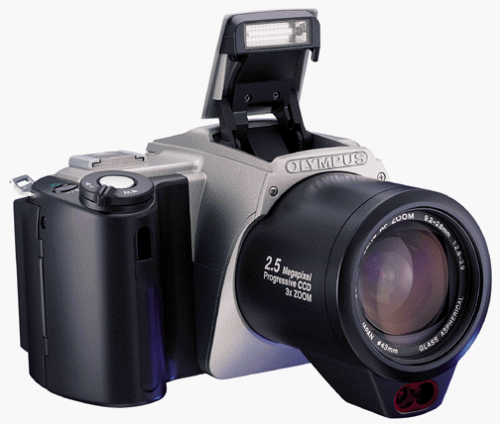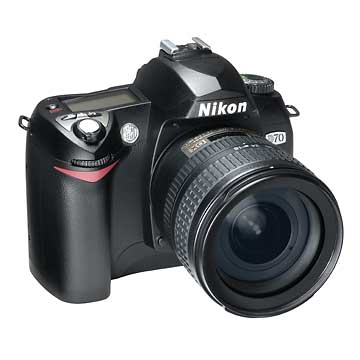 My last real camera was an Olympus C-2500L digital camera purchased in late 1999. It was my first digital camera and the merging of two dreams: digital images and SLR cameras.
My last real camera was an Olympus C-2500L digital camera purchased in late 1999. It was my first digital camera and the merging of two dreams: digital images and SLR cameras.
I’ve been obsessed with digital images ever since 1984 when I first played with MacPaint. When I got my Macintosh in late 1985, I got a video digitizer and a ThunderScan (a line-by-line scanner that would hook up to an Apple ImageWriter). I thought about digital photography ever since the Apple QuickTake came out. By 1999 quality digital cameras were finally becoming affordable and I was ready to purchase one.
If it was a digital camera, it had to be single lens reflex. When I was a kid, my father would often take pictures from his Pentax, the inventors of the pentaprism which is the key to the SLR. As a kid, I had to live with those 110 film pocket cameras, but I made sure to get one that reminded me of an SLR—it had a little barrel you could pull out to “zoom” the plastic lens and it lasted until junior high school where a fall cause something to get knocked off of its mount. I still have the photos.
After college, when point and shoots became affordable, the SLR still wasn’t but instead of buying a traditional point-and-shoot, I bought the Olympus IS-10, the first “bridge” camera. Olympus called it a ZLR because it was a SLR with a fixed zoom lens and electronics much like a point-and-shoot. But you could look through the lens, and the film had improved to the point where taking photos was a joy.
But I dropped it, repaired it, dropped it, repaired it, dropped it, gave up. That lasted me until 1999. By this time I was in graduate school and burning through film so fast that it was eating into my budget. The Olympus C-2500L with a street price of $1000 and a 2.5 megapixel CCD with a wonderfully large light gathering lens was perfection. It felt and behaved just like my IS-10 and I took tons of shots with it.
Just when I figured it out, I got submerged by an ocean wave while hiking in 2003 and it didn’t survive. I was too poor to purchase my dream replacement: the Canon 10D ($1500 for body only) so I waited.
Then the Canon 300D came out at $1000 including lens and I still waited. By now, it’s silver-colored plastic looked cheap. But the real deal killer was the simple reality that its menu-driven system performed differently from Canon’s higher end camera. It took me years to figure out the C-2500L and that was after owning a similar film-based predecessor, I wasn’t going to go through the same hell again for a measly few hundred dollars savings.
 Finally the Nikon D70 came out for $1000 without the lens. It was a tough decision, but I was richer now and I had a soft spot for Nikons since I used to drool of their F-series cameras and amazingly expensive lenses when I had to settled on the IS10. The D70 like the 300D had a plastic body; but this plastic body didn’t feel cheap. And the kit lens was a thing of beauty: 18-70mm at 1.5x with a f/3.5-4.5, ED glass, and silent wave motor—a photo geek’s dream for $300 more.
Finally the Nikon D70 came out for $1000 without the lens. It was a tough decision, but I was richer now and I had a soft spot for Nikons since I used to drool of their F-series cameras and amazingly expensive lenses when I had to settled on the IS10. The D70 like the 300D had a plastic body; but this plastic body didn’t feel cheap. And the kit lens was a thing of beauty: 18-70mm at 1.5x with a f/3.5-4.5, ED glass, and silent wave motor—a photo geek’s dream for $300 more.
Sure there is the Canon 20D, I knew it would come out before I even bought the Nikon. It’s a different class camera at $1500 without the lens. But consider this: one nice little touch noted by reviewers of the Canon 20D is Canon now embosses their name to the front of the camera instead of silkscreening it like on their older models: 10D ($1500) and 300D ($900). The Nikon D70? Embossed logo all along.
It is those little things that let you know you bought the right camera.
Nikon has updated the Nikon D70 to the Nikon D70s. Caitlin points out that the Nikon D70 kit is going for $900 which is about $400 cheaper than what I paid half a year ago. Not a bad depreciation.
After using a pro-end Canon, I’m not sweating the features in the D70s which are a nice convenience. My next camera will be some version of the D2X or sequel in a number of years. I hope the D70 will continue to work until then.
Nikon profit soars, raises outlook